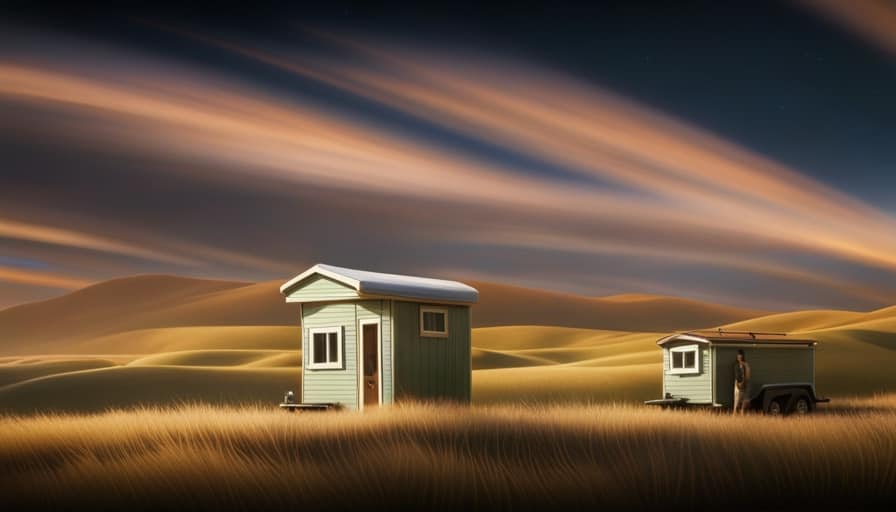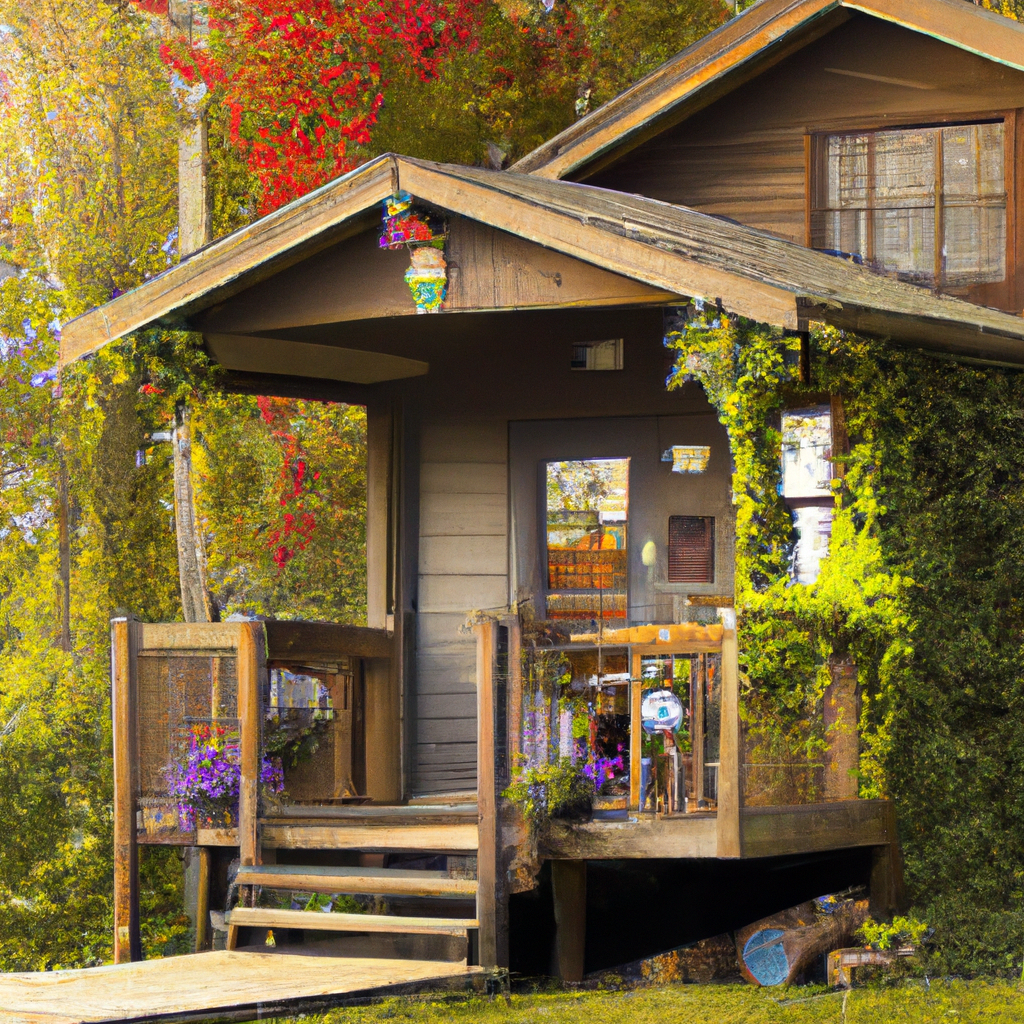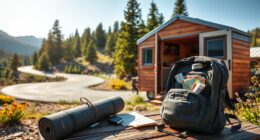Are you aware that the average American household consumes approximately 10,649 kilowatt-hours of electricity annually? That’s quite a significant amount of power!
But what if you could brighten your compact home while using a fraction of that energy?
In this article, we’ll show you how to master the utilities in your tiny house, from choosing the right power source to setting up your water supply.
Get ready to create a comfortable and efficient living space that serves your needs.
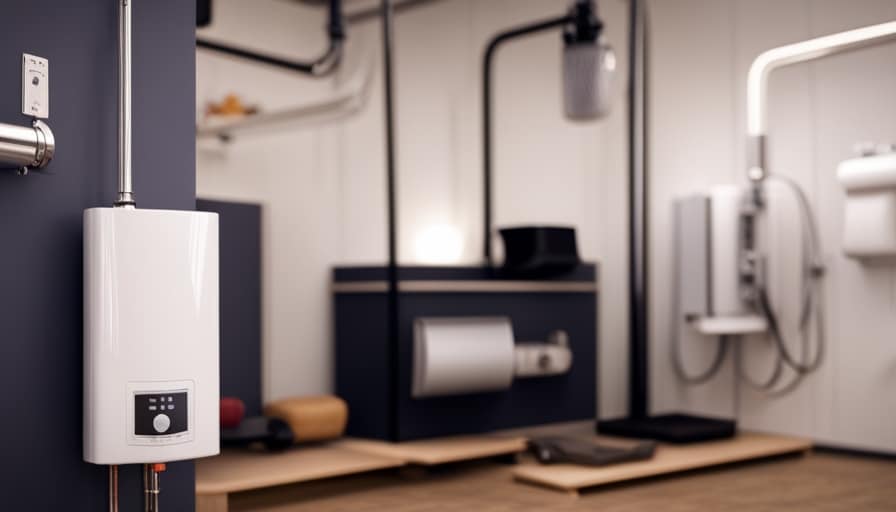
Key Takeaways
- Off-grid systems offer independence, self-sufficiency, and clean energy generation
- Installing a solar system allows for the generation of clean and renewable energy
- Installing a water filtration system ensures clean and safe drinking water
- Propane is a reliable and efficient choice for heating in small spaces
Choosing Your Power Source: Grid or Off-Grid
We’ve made the decision on our power source for our tiny house: off-grid solar panels.
When it comes to choosing a power source for a tiny house, there are two main options to consider: being connected to the grid or going off-grid. Many people opt for off-grid systems because they offer several advantages over relying solely on the grid or a generator.
Firstly, off-grid solar panels provide us with independence and self-sufficiency, allowing us to generate our own clean and renewable energy.
Secondly, we don’t have to worry about power outages or fluctuations in utility prices.

Lastly, off-grid systems are eco-friendly, reducing our carbon footprint. By harnessing the sun, we can tap into its abundant energy and create a sustainable power source for our tiny home.
Now, let’s explore the process of installing a solar system.
Harnessing the Sun: Installing a Solar System
Installing a solar system in our tiny house involves carefully positioning the panels and connecting them to the battery bank. To maximize solar panel efficiency, it’s crucial to install them in an area that receives ample sunlight throughout the day. Ideally, this would be on the roof or in an open space where there’s minimal shade.
Once the panels are installed, they need to be connected to a solar battery storage system. This allows us to store excess energy generated during the day and use it during the night or when the sun isn’t shining. The battery bank should be placed in a cool and well-ventilated area to ensure optimal performance and longevity.
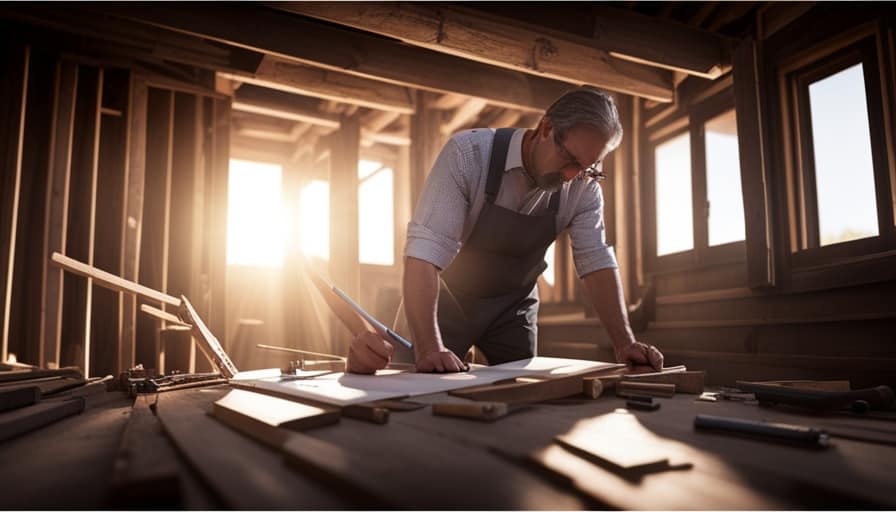
Meeting Your Water Needs: Setting Up a Water Supply
To ensure a reliable water supply, our tiny house needs a well or a connection to a local water source. Here are some practical ways to meet our water needs:
-
Water Filtration: Installing a water filtration system is crucial to ensure clean and safe drinking water. There are various options available, including activated carbon filters, reverse osmosis systems, and UV sterilizers. Choose a filtration system that suits our needs and budget.
-
Rainwater Collection: Harvesting rainwater is an excellent way to reduce our reliance on traditional water sources. Install a rainwater collection system that includes gutters, downspouts, and a storage tank. Use this collected water for non-potable purposes such as watering plants, flushing toilets, and doing laundry.
-
Connection to Local Water Source: If a well isn’t feasible, connecting our tiny house to a local water source is the next best option. Ensure that the connection complies with local regulations and consider installing a water meter to track usage and manage consumption efficiently.
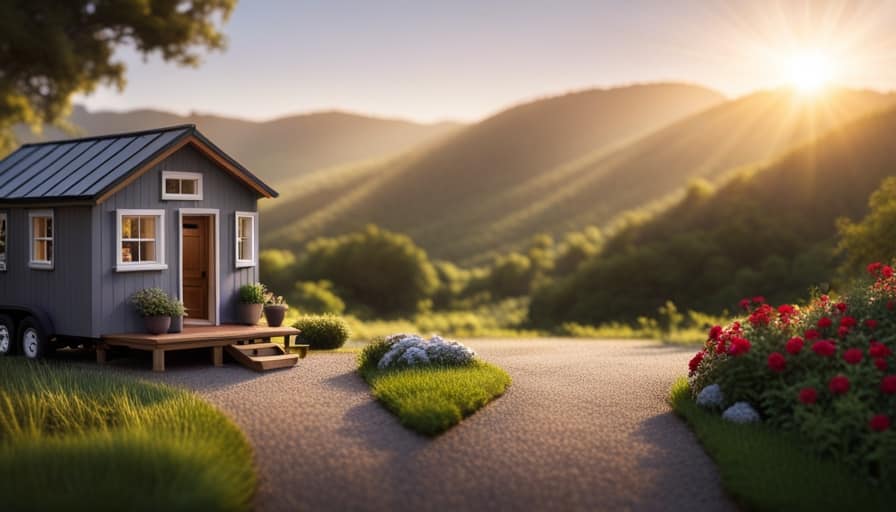
Managing Waste: Installing a Septic System
But before we get into that, let’s talk about managing waste in our tiny house by installing a septic system. Waste management is an important aspect of sustainable living, especially in a compact space. One option for waste disposal in a tiny house is using composting toilets. These toilets separate solid and liquid waste, allowing for the decomposition of organic matter. This process creates nutrient-rich compost that can be used in gardening. Installing a septic system is another viable option. A septic system consists of a tank where waste is collected and treated before being released into the ground. This system requires regular maintenance, such as periodic pumping. Proper waste management is essential for maintaining a clean and healthy living environment in our tiny homes.
| Pros | Cons |
|---|---|
| Sustainable | Regular maintenance required |
| Nutrient-rich compost | Higher initial cost |
| Environmentally friendly | Requires space for installation |
| Reduces water usage |
Keeping Warm and Cooking: Establishing a Propane Setup
Let’s talk about keeping warm and cooking in your tiny house by establishing a propane setup.
When it comes to heating options, propane can be a reliable and efficient choice for small spaces.
Propane offers convenience and flexibility, allowing you to prepare meals without the need for a traditional kitchen setup. Cooking with propane is a great option for tiny house living.
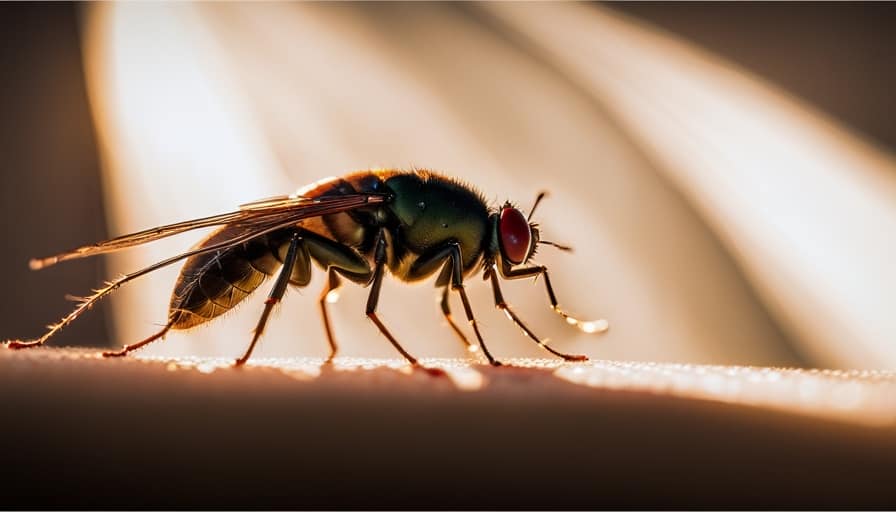
By setting up a propane system in your tiny house, you can easily regulate the temperature and keep your space cozy during colder months.
In addition to heating, propane can also power your stove and oven, providing you with a convenient way to cook your meals.
Having a propane setup in your tiny house allows you to have a fully functional kitchen without the need for extensive plumbing or electrical work.
With a propane system, you can cook all your favorite meals and enjoy the benefits of a traditional kitchen, even in a small space.

Propane Heating Options
We’ve found that using a single propane tank for both heating and cooking is the most efficient option for our tiny house. Propane offers a safe and reliable heating solution, especially in small spaces where electric heating may not be practical.
Here are a few reasons why we prefer propane heating:
-
Cost-effective: Propane is often more affordable than electricity, making it a budget-friendly choice for heating our tiny house.
-
Energy-efficient: Propane heaters are highly efficient, converting a large percentage of fuel into heat. This means we can stay warm without wasting energy.

-
Versatility: Propane can be used for multiple purposes, including heating, cooking, and even powering appliances like refrigerators or water heaters.
Cooking With Propane
We can easily cook with propane in our tiny house by setting up a propane stove and ensuring proper ventilation for safety. Propane stoves are a popular choice for cooking in small spaces due to their compact size and efficient heat output.
To set up a propane stove, you’ll need to connect it to a propane tank using a regulator and hose. Make sure to follow the manufacturer’s instructions and check for any leaks before using the stove.
When cooking with propane, it’s important to practice propane safety by keeping flammable materials away from the stove, never leaving it unattended, and ensuring proper ventilation to prevent carbon monoxide buildup.
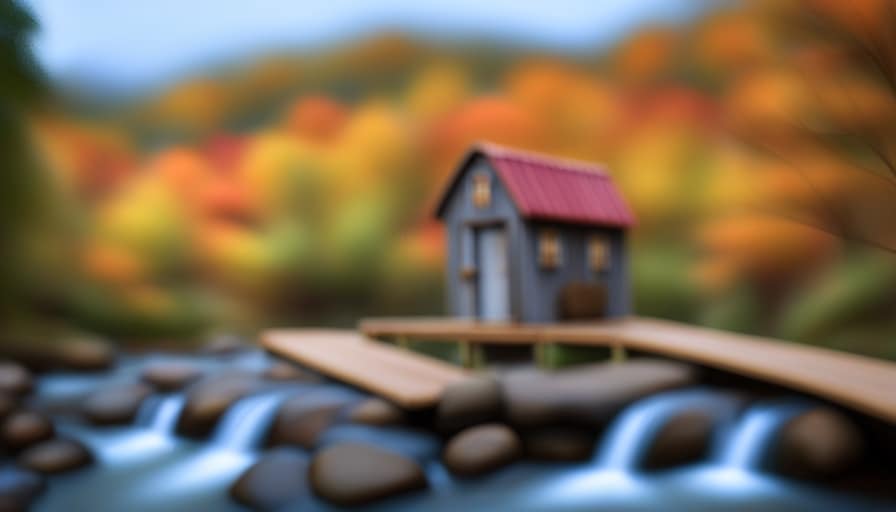
Staying Connected: Installing Internet and Phone Lines
Installing internet and phone lines can be a crucial step in staying connected in our tiny home. To ensure a seamless connection, we started by installing fiber optic cables to optimize our Wi-Fi speed. This allows us to stream movies, video call loved ones, and work remotely without any interruptions.
We strategically placed our Wi-Fi router in a central location to maximize coverage throughout the house. Additionally, we invested in a Wi-Fi extender to reach every corner of our compact home. This ensures that no matter where we are, we can always stay connected.
Frequently Asked Questions
How Much Does It Cost to Switch From a Grid Power Source to an Off-Grid Power Source?
Switching from a grid power source to an off-grid power source involves a cost comparison. We weigh the expenses of installation, maintenance, and equipment for both options. It’s important to consider long-term savings and environmental impact.
Are There Any Government Incentives or Grants Available for Installing a Solar System in a Tiny House?
Yes, there are government incentives available for installing a solar system in a tiny house. These incentives can help offset the initial costs and make the installation more affordable.
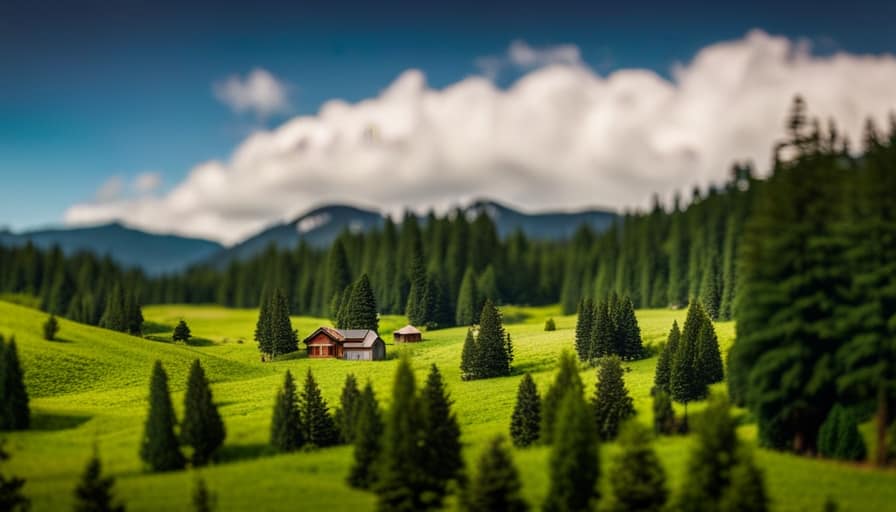
What Are the Maintenance Requirements for a Septic System in a Tiny House?
Maintaining a septic system in a tiny house is crucial. Regular pumping, inspecting pipes, and using septic-safe products are like giving your system a tune-up. It’s a cost-effective way to keep your off-grid power switch running smoothly.
Can I Use an Electric Heating System Instead of a Propane Setup to Keep My Tiny House Warm?
Using an electric heating system instead of propane in a tiny house has pros and cons. Electric is more efficient and easier to install, but it may require a larger electrical system and can be more expensive to operate.
What Are the Options for Internet and Phone Service in Remote Areas Where Tiny Houses Are Typically Located?
In remote areas where tiny houses are typically located, options for internet and phone service providers may be limited. Satellite internet is often the best choice for reliable connectivity in these areas.
Conclusion
In conclusion, by choosing the right power source, harnessing the sun’s energy, setting up a water supply, and installing a septic system, you can create a compact home that’s efficient and functional.

Additionally, establishing a propane setup and installing internet and phone lines can further enhance the functionality and comfort of your tiny house.
These utilities, like a well-oiled machine, work together to brighten your tiny house and make it feel like a cozy haven amidst the hustle and bustle of the world.
I’m Theodore, and I love tiny houses. In fact, I’m the author of Tiny House 43, a book about tiny houses that are also tree houses. I think they’re magical places where imaginations can run wild and adventures are just waiting to happen.
While tree houses are often associated with childhood, they can be the perfect adult retreat. They offer a cozy space to relax and unwind, surrounded by nature. And since they’re typically built on stilts or raised platforms, they offer stunning views that traditional homes simply can’t match.
If you’re looking for a unique and romantic getaway, a tree house tiny house might just be the perfect option.




